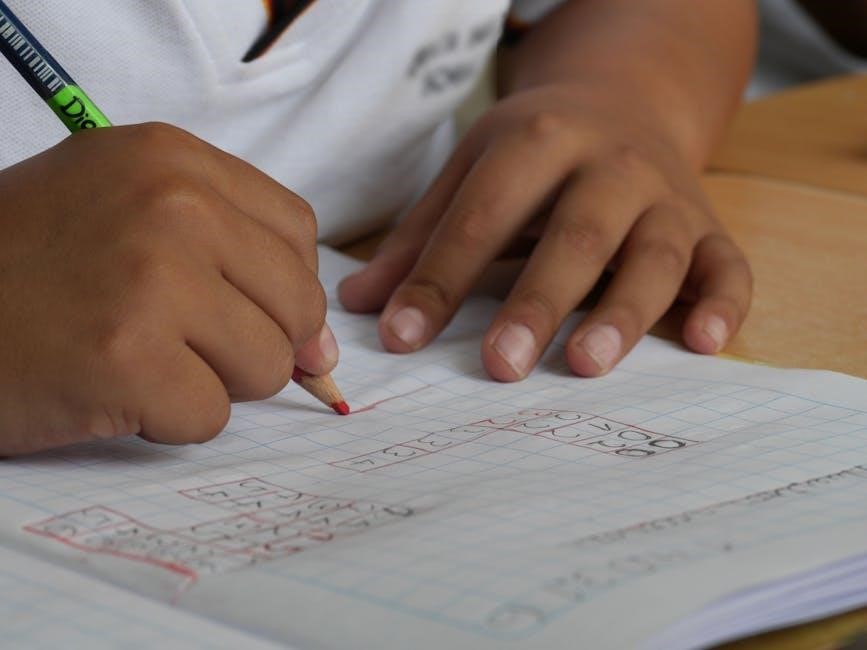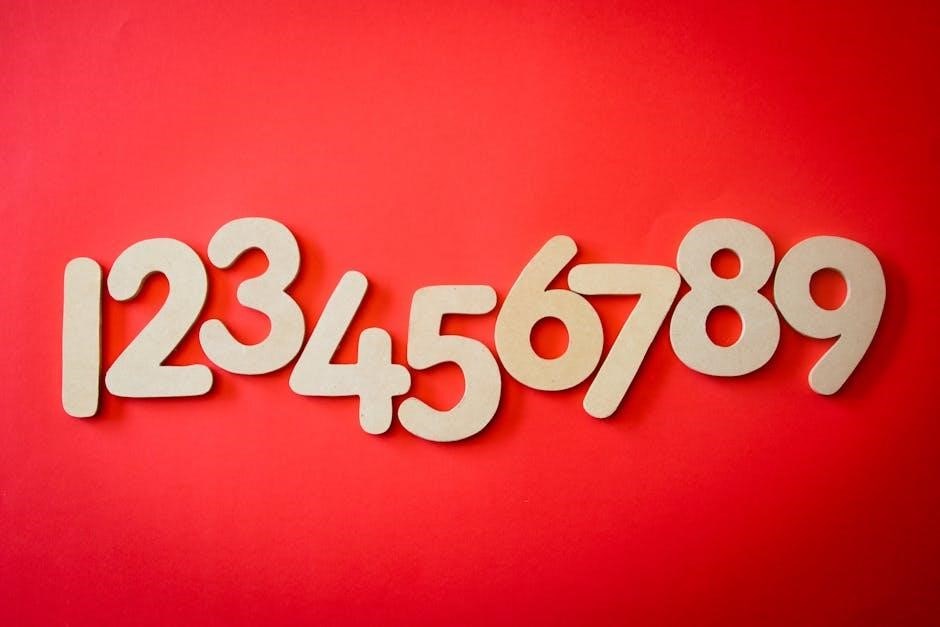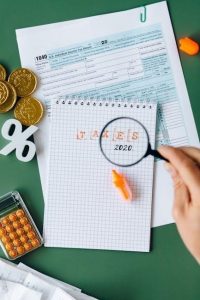Mixed numbers combine whole numbers and fractions, while improper fractions have larger numerators than denominators. Both are essential in math for simplifying calculations and real-world applications.
1.1 Definition of Mixed Numbers
A mixed number is a combination of a whole number and a proper fraction. For example, in the mixed number 3 1/2, 3 is the whole number, and 1/2 is the fractional part. Mixed numbers are used to represent quantities that are more than a whole but less than the next whole number. They are commonly used in real-world measurements, such as cooking or construction, where precise quantities are essential. The format of a mixed number is a b/c, where a is the whole number, and b/c is the fractional part. Understanding mixed numbers is foundational for converting them to improper fractions, which are essential for advanced mathematical operations.
1.2 Definition of Improper Fractions
An improper fraction is a fraction where the numerator is greater than or equal to the denominator. For instance, 5/3 is an improper fraction because 5 is larger than 3. Improper fractions differ from proper fractions, where the numerator is smaller than the denominator. They are useful in mathematical operations like addition and subtraction, as they eliminate the need to work with whole numbers separately. Improper fractions can also be converted to mixed numbers, which combine a whole number with a proper fraction. This conversion is a fundamental skill in fraction arithmetic, often practiced using worksheets that provide structured exercises for mastery. Understanding improper fractions is crucial for advanced math concepts and real-world applications.
1.3 Importance of Converting Between Mixed Numbers and Improper Fractions
Converting between mixed numbers and improper fractions is vital for simplifying mathematical operations. Mixed numbers combine whole numbers and proper fractions, while improper fractions represent the same value as a single fraction. This conversion is essential for tasks like adding, subtracting, and comparing fractions, as improper fractions eliminate the need to handle whole numbers separately. Worksheets dedicated to this skill help students master the process, ensuring accuracy in calculations. Understanding this conversion enhances problem-solving abilities and prepares students for advanced math topics. Regular practice through worksheets reinforces these skills, making fraction arithmetic more intuitive and efficient for real-world applications and academic success.

Understanding the Conversion Process
Conversion involves multiplying the whole number by the denominator, adding the numerator, and placing over the original denominator for improper fractions. Worksheets simplify practice.
2.1 Step-by-Step Guide to Converting Mixed Numbers to Improper Fractions
To convert a mixed number to an improper fraction, follow these steps:
- Identify the whole number and the fraction part of the mixed number.
- Multiply the whole number by the denominator of the fraction.
- Add the numerator of the fraction to the result from step 2.
- Place the sum from step 3 over the original denominator to form the improper fraction.
For example, to convert 3 1/2 to an improper fraction:
- Whole number = 3, fraction = 1/2.
- 3 × 2 = 6.
- 6 + 1 = 7.
- Improper fraction = 7/2.
This method ensures accuracy and simplifies the process for practice with worksheets.
2.2 Step-by-Step Guide to Converting Improper Fractions to Mixed Numbers
Converting improper fractions to mixed numbers involves dividing the numerator by the denominator:
- Divide the numerator by the denominator to find the whole number.
- Use the remainder as the new numerator, keeping the denominator the same.
- Combine the whole number with the new fraction.
For example, to convert 7/2 to a mixed number:
- 7 ÷ 2 = 3 with a remainder of 1.
- Remainder = 1, denominator = 2.
- Mixed number = 3 1/2.
This process is straightforward and can be practiced effectively with downloadable worksheets in PDF format.
2.3 Common Mistakes to Avoid During Conversion
When converting between mixed numbers and improper fractions, common errors include forgetting to add the numerator after multiplying the whole number by the denominator, and misplacing the remainder when converting back. Additionally, students often mistakenly alter the denominator or fail to format the mixed number correctly. Rushing through problems without double-checking each step can lead to inaccuracies. Practicing with structured worksheets and carefully following each step helps minimize these errors and ensures accurate conversions.

Benefits of Using Worksheets for Practice
Worksheets provide structured practice, enhancing understanding and retention of fraction conversion skills. They offer clear examples, organized exercises, and instant feedback, making learning engaging and effective.
3.1 Why Worksheets Are Effective for Learning Fraction Conversion
Worksheets are effective because they provide structured, hands-on practice. They allow students to apply conversion methods in a clear, step-by-step manner, reinforcing understanding. With specific exercises, they target areas needing improvement, ensuring mastery. The visual format aids in organizing thoughts, making complex concepts manageable. Immediate feedback through answers helps identify mistakes early. Worksheets also cater to different learning paces, offering flexibility. Their portability makes them ideal for homework or study sessions. Overall, worksheets create a focused learning environment, essential for grasping fraction conversion skills confidently.

3.2 How Worksheets Reinforce Math Skills
Worksheets reinforce math skills by providing repetitive, focused practice that builds confidence and fluency. They allow students to apply fraction conversion methods in a structured format, reinforcing understanding through hands-on exercises. The clear layout helps students visualize relationships between mixed numbers and improper fractions, making abstract concepts more tangible. Worksheets also cater to different learning styles, offering visual and kinesthetic engagement. Regular practice with worksheets strengthens problem-solving abilities and improves accuracy. Additionally, they provide immediate feedback, allowing students to identify and correct mistakes. Over time, consistent use of worksheets develops a strong foundation in fraction conversion, enabling students to approach more complex math problems with ease and assurance.
3.3 Tips for Using Worksheets Effectively
To maximize the benefits of worksheets, set clear goals for each practice session. Start with simpler problems to build confidence before moving to more challenging ones. Ensure students understand the concept of fraction conversion before diving into exercises. Use visual aids like fraction bars or models to reinforce learning. Encourage students to work independently but provide guidance when needed. Regularly review mistakes to identify patterns and address weaknesses. Incorporate timed drills to improve speed and accuracy. Rotate between mixed numbers and improper fractions to maintain variety. Celebrate progress, no matter how small, to keep motivation high. Finally, supplement worksheets with real-world examples to demonstrate practical applications.

Designing a Mixed Numbers to Improper Fractions Worksheet
Ensure clarity by using clear instructions, varied problem types, and visual aids like fraction models. Include both conversion directions and ensure proper spacing for easy readability in PDF format.
4.1 Key Elements of a Well-Structured Worksheet
A well-designed worksheet should include clear instructions, varied problem types, and visual aids like fraction models to enhance understanding. Ensure problems progress from simple to complex, catering to different skill levels.
Include both mixed-to-improper and improper-to-mixed conversions to reinforce bidirectional skills. Provide ample space for calculations to avoid clutter. Add answer keys or solutions for self-checking.
Use consistent formatting and readable fonts. Incorporate colour-coded fraction bars for visual learners. Offer a mix of numerical and real-world problems to apply concepts practically. Include examples and step-by-step guides for reference.
Ensure the PDF is easily printable and compatible with all devices for accessibility.
4.2 How to Create a Worksheet in PDF Format
Creating a worksheet in PDF format involves designing it with clarity and functionality. Begin by outlining the structure, ensuring clear headings and sections. Use software like Adobe Acrobat or online tools to format the content.
Include problem sets with adequate spacing for answers. Add visual aids like fraction bars or diagrams to enhance understanding.
Ensure the PDF is mobile-friendly and printable. Save the file with a descriptive name, such as “Mixed_Numbers_to_Improper_Fractions_Worksheet.pdf.”
Finally, test the PDF to confirm all elements display correctly and the file size is manageable for easy sharing and printing.
4.3 Examples of Questions for Different Skill Levels
Worksheets should cater to various skill levels to accommodate diverse learners. For beginners, include simple conversion tasks, such as converting 1 1/2 to an improper fraction. Intermediate questions might involve multi-step problems, like adding mixed numbers and converting the result. Advanced sections can include word problems, such as calculating ingredients for a recipe. Incorporate visual aids for younger students, while older learners can benefit from algebraic applications. Ensure each question set builds on the previous one, reinforcing concepts progressively. Providing answers separately helps in self-assessment and understanding. This structured approach ensures comprehensive practice and mastery of fraction conversion skills.

Educational Resources for Mixed Numbers and Improper Fractions
Find printable PDF worksheets, interactive tools, and online tutorials to practice converting mixed numbers and improper fractions. These resources cater to various grade levels and learning styles.
5.1 Recommended Websites for Printable Worksheets
Several websites offer free printable worksheets for converting mixed numbers to improper fractions. K5 Learning provides grade-specific worksheets ideal for students in grades 4 to 7. Free PDF worksheets tailored for grade-specific learning are widely available online. For grade 4, worksheets focus on basic conversion skills, while grade 5 materials introduce more complex problems. Grade 6 and 7 worksheets often include mixed operations and word problems to enhance understanding. Websites like K5 Learning and Soft Schools provide downloadable resources designed to align with curriculum standards. These PDFs are easily accessible, allowing teachers and parents to print them instantly. They feature clear instructions and ample practice questions, making them ideal for classroom use or homeschooling. Regular practice with these worksheets helps students build confidence and mastery in converting mixed numbers to improper fractions. Interactive tools offer engaging ways to practice fraction conversion. Websites like K5 Learning and Math Playground provide online exercises where students can convert mixed numbers to improper fractions and vice versa. These tools often feature visual aids, such as fraction bars and models, to help students understand the relationship between the two forms. Many platforms include drag-and-drop activities, quizzes, and games that make learning fun and interactive. Some tools also offer real-time feedback, allowing students to track their progress. These resources are particularly useful for visual learners and those who benefit from hands-on practice. By incorporating technology, interactive tools make fraction conversion more accessible and enjoyable for students of all skill levels. Fraction conversion is essential in cooking for accurate recipes, in construction for precise measurements, and in finance for calculating investments and budgets, ensuring efficiency and accuracy in daily tasks. Cooking often requires precise measurements, making mixed numbers and improper fractions indispensable. For example, a recipe might call for 1 1/2 cups of flour (a mixed number) or 3/2 cups of sugar (an improper fraction). Converting between these forms ensures accuracy, as scaling recipes up or down requires clear fraction handling. Bakers frequently use fractions to measure ingredients like yeast or baking powder, where even small errors can affect results. Additionally, understanding fraction conversion aids in adjusting serving sizes or substituting ingredients, making it a valuable skill for home cooks and professional chefs alike. Worksheets on fraction conversion are a great way to practice these essential culinary math skills. Fraction conversion is crucial in construction and measurements, where precision is key. Builders often encounter mixed numbers and improper fractions when calculating materials. For instance, a beam might measure 2 3/4 feet, while another might be 11/4 feet. Converting these ensures accurate cuts and fittings. Contractors use fractions for tasks like scaling blueprints or mixing materials, where errors can lead to costly mistakes. Worksheets on fraction conversion help professionals and students master these skills, ensuring efficiency and accuracy in their work. Understanding both mixed numbers and improper fractions is vital for successful project execution in the construction industry. This skill transcends the classroom, becoming a practical tool for real-world applications. Fractions play a significant role in financial calculations, where precision is essential. Investors use mixed numbers and improper fractions to calculate returns, such as converting percentages into decimal form. For example, a 4.5% annual return can be expressed as the fraction 9/20. This skill is crucial for budgeting, tax calculations, and investment decisions. Worksheets on fraction conversion help professionals and students master these skills, ensuring accuracy in financial planning. Understanding how to convert between mixed numbers and improper fractions simplifies tasks like calculating dividends or interest rates, making it a vital tool for personal and business finance. These practical applications highlight the importance of fraction conversion in maintaining financial health. Regular practice with worksheets reinforces these essential skills. Use visual aids and real-world examples to simplify concepts. Incorporate times tables for conversion ease and provide structured worksheets for consistent practice. Break complex steps into manageable parts. Breaking down complex fraction conversions into smaller steps helps students grasp the process. Using visual aids like fraction bars or pie charts makes abstract concepts tangible. Real-world examples, such as measuring ingredients in cooking, illustrate practical applications. Providing step-by-step guides and practice worksheets allows students to build confidence gradually. Encouraging peer-to-peer learning fosters collaboration and deeper understanding. Incorporating interactive tools and games can make learning engaging and fun. Offering immediate feedback on worksheets helps students identify and correct mistakes quickly. By combining these strategies, teachers can create a supportive environment that caters to different learning styles and paces. Visual aids are invaluable for teaching fraction conversions, as they transform abstract concepts into tangible representations. Tools like fraction bars, pie charts, and number lines help students visualize how mixed numbers and improper fractions relate. Coloring fraction bars, for instance, allows learners to see how whole numbers and fractions combine. Interactive models, such as digital fraction builders, enable hands-on exploration. Real-world examples, like measuring ingredients in recipes, further clarify the practical use of these concepts. By integrating visual and interactive elements, educators can cater to diverse learning styles, making the conversion process more intuitive and engaging for students of all ages and skill levels. Peer-to-peer learning fosters collaboration and reinforces understanding of fraction conversions. By pairing students, they can explain concepts like mixed numbers and improper fractions to one another, enhancing communication skills. Group activities, such as solving worksheets together or discussing problem-solving strategies, create a supportive environment. This approach not only strengthens math skills but also builds confidence. Encouraging students to teach each other promotes active learning and ensures that everyone grasps the material. Collaborative efforts make the learning process engaging and dynamic, preparing students for independent practice and real-world applications of fraction conversion. Mastering the conversion between mixed numbers and improper fractions enhances math proficiency and practical problem-solving abilities. Regular practice with worksheets ensures long-term understanding and confidence. To master mixed numbers and improper fractions, consistent practice is key. Start by understanding the relationship between whole numbers and fractions. Use worksheets in PDF format to practice conversions regularly. Visualizing fractions with diagrams can enhance comprehension. Breaking down problems into smaller steps simplifies complex conversions. Encourage peer learning to discuss challenges and solutions. Utilize online tools and tutorials for interactive practice. Apply real-world examples, such as cooking or measurements, to see the practical relevance of these concepts. Regular review and patience will solidify your skills, making fraction conversion second nature over time. For further practice, visit www.k5learning.com for grade-specific worksheets. Download PDF resources from educational websites like Math Worksheets Land and SoftSchools for comprehensive fraction conversion tools. For in-depth understanding, explore “Mastering Fractions: A Comprehensive Guide” and “Fraction Conversion Made Easy”. These resources provide detailed explanations and practice exercises. Downloadable PDF guides from Math Worksheets Land and SoftSchools offer step-by-step instructions and interactive tools. Additionally, “Fraction Basics for Grades 4-6” is ideal for younger learners, with visual aids and real-world examples. These materials are perfect for reinforcing concepts and improving problem-solving skills. They include mixed number and improper fraction conversions, ensuring a solid foundation. Use these resources alongside worksheets for comprehensive learning. Always complete exercises and check answers for accuracy. These guides are invaluable for both students and educators seeking to master fraction conversion. Tip: Use times tables to simplify conversions quickly! Enhance your learning with online tutorials from trusted platforms like Math Worksheets Land and SoftSchools. These websites offer free, downloadable PDF guides and interactive tools for converting mixed numbers to improper fractions. Explore Khan Academy for video lessons that break down complex concepts into simple steps. Math Antics provides engaging tutorials with visual aids and practice exercises. For hands-on practice, visit IXL for interactive fraction conversion drills. These resources are ideal for students and educators seeking to master fraction conversion. Use these links to access step-by-step guides, printable worksheets, and self-checking exercises. They are perfect for reinforcing skills and ensuring a solid understanding of mixed numbers and improper fractions. Start learning today and improve your math skills effortlessly! Reinforce your understanding with downloadable PDF worksheets from Math-Drills and Worksheets Guru. These resources provide a variety of exercises for converting mixed numbers to improper fractions and vice versa. Each worksheet includes clear instructions and answer keys for self-assessment. For targeted practice, Education.com offers grade-specific worksheets tailored to different skill levels. Additionally, Teachers Pay Teachers features customizable worksheets with engaging visuals. Print these worksheets to create a comprehensive study package. Regular practice with these materials will help build confidence and fluency in handling mixed numbers and improper fractions. Make learning fun and effective with these printable resources designed for all learners!5.2 Free PDF Worksheets for Grade-Specific Learning
5.3 Interactive Tools for Practicing Fraction Conversion

Real-World Applications of Fraction Conversion
6.1 Using Mixed Numbers and Improper Fractions in Cooking
6.2 Fraction Conversion in Construction and Measurements
6.3 Role of Fractions in Financial Calculations


Best Practices for Teaching Fraction Conversion
7.1 Strategies for Simplifying Complex Concepts
7.2 Incorporating Visual Aids for Better Understanding
7.3 Encouraging Peer-to-Peer Learning
8.1 Summary of Key Points
8.2 Final Tips for Mastering Mixed Numbers and Improper Fractions

References and Additional Resources
9.1 Suggested Reading Materials
9.2 Links to Helpful Online Tutorials
9.3 Printable Worksheets for Further Practice


